Direct Numerical Simulation of Fog: The Sensitivity of a Dissipation Phase to Environmental Conditions
Abstract
:1. Introduction
2. Theory
3. Numerical Simulation
3.1. Simulation Setup and Initialization
3.2. Boundary Conditions
3.3. Sensitivity Studies
4. Results
4.1. The Effect of the Free Troposphere Temperature
4.2. The Effect of the Free Troposphere Relative Humidity
4.3. The Effect of Moisture Lapse Rate on Fog Depletion
4.4. The Effect of Longwave Radiative Cooling
4.5. Fog Depletion Mechanisms
5. Discussion
6. Conclusions and Perspectives
Funding
Acknowledgments
Conflicts of Interest
Abbreviations
| DNS | direct numerical simulation |
| FT | free troposphere |
| LES | large eddy simulation |
| LWC | liquid water content |
| LWP | liquid water path |
| TKE | turbulent kinetic energy |
Appendix A. Problem Formulation
Appendix B. Convergence Study and Initialization
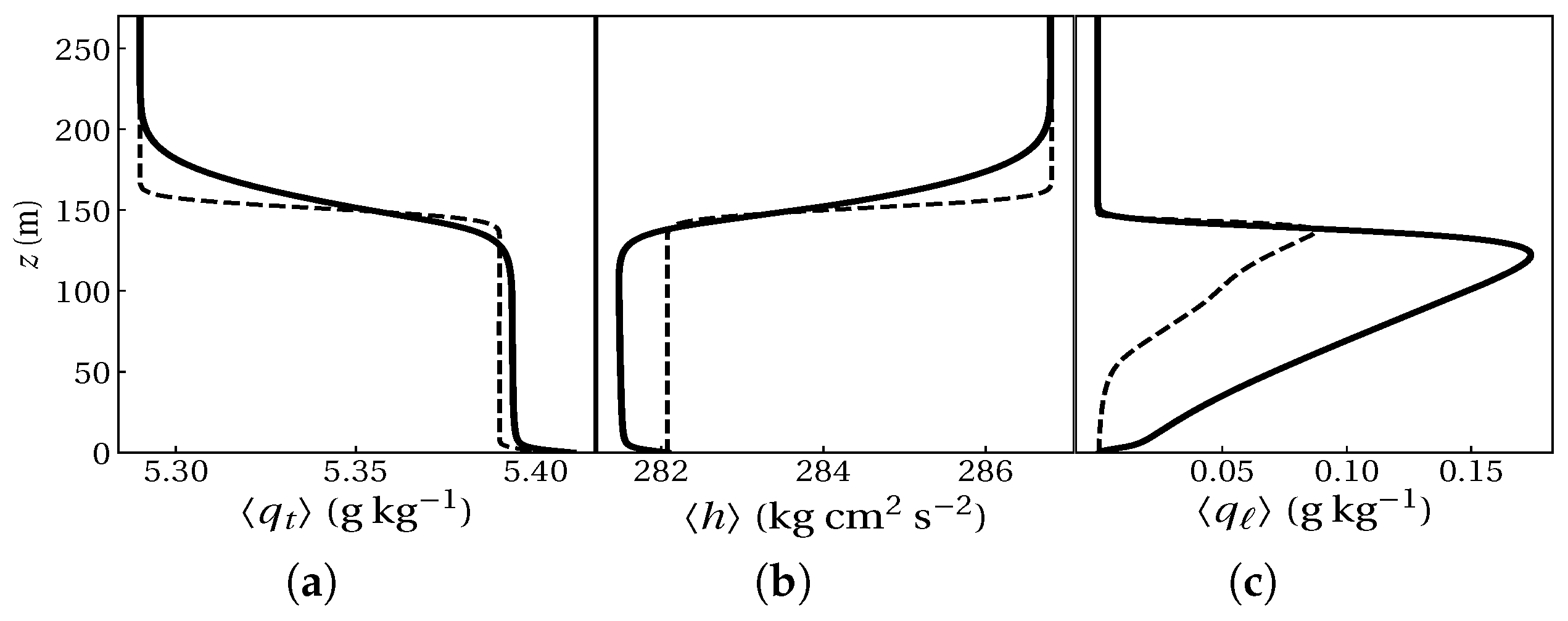
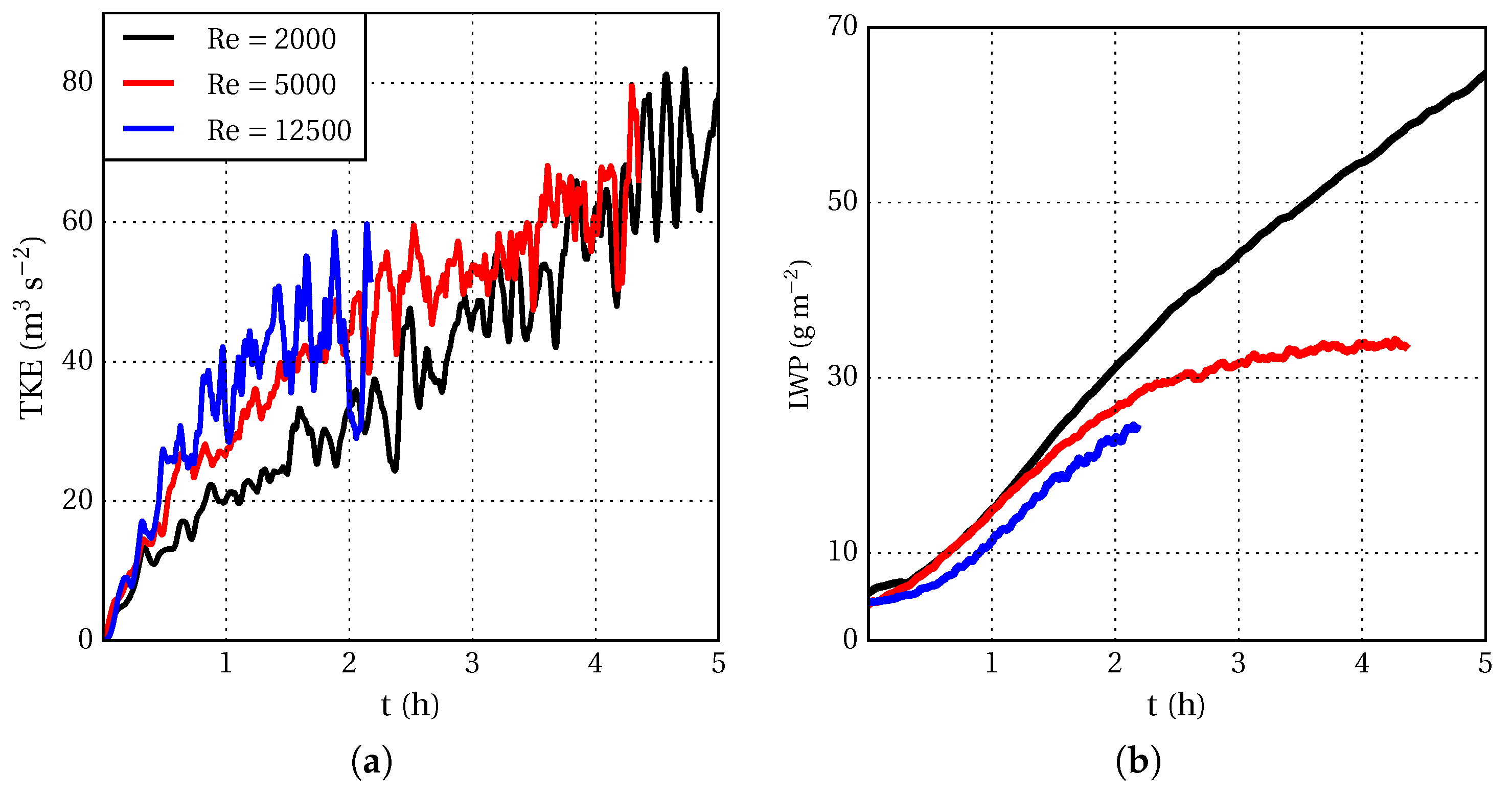
References
- Lohmann, U.; Lüönd, F.; Mahrt, F. An Introduction to Clouds: From the Microscale to Climate; Cambridge University Press: Cambridge, UK, 2000. [Google Scholar]
- Tardif, R.; Rasmussen, R.M. Event-Based Climatology and Typology of Fog in the New York City Region. J. Appl. Meteorol. Climatol. 2007, 46, 1141–1168. [Google Scholar] [CrossRef] [Green Version]
- Syed, B.F.S.; Kornich, H.; Tjernstrom, M. On the fog variability over south Asia. Clim. Dyn. 2012, 39, 1993–2005. [Google Scholar] [CrossRef]
- Li, Z.; Eck, T.; Zhang, Y.X.; Zhang, D.L.; Li, L.; Xu, H.; Hou, W.; Lv, Y.; Goloub, P.; Gua, X. Observations of residual submicron fine aerosol particles related to cloud and fog processing during a major pollution event in Beijing. Atmos. Environ. 2014, 86, 187–192. [Google Scholar] [CrossRef]
- Agarwal, A.; Mangal, A.; Satsangi, A.; Lakhani, A.; Kumari, K. Characterization, sources and health risk analysis of PM 2.5 bound metals during foggy and non-foggy days in sub-urban atmosphere of Agra. Atmos. Res. 2017, 197, 121–131. [Google Scholar] [CrossRef]
- Gultepe, I.; Tardif, R.; Michaelides, C.; Cermak, J.; Bott, A.; Bendix, J.; Mueller, M.D.; Pagowski, M.; Hansen, B.; Ellrod, G.; et al. Fog Research: A Review of Past Achievements and Future Perspectives. Pure Appl. Geophys. 2007, 164, 1121–1159. [Google Scholar] [CrossRef]
- Johnstone, J.A.; Dawson, T.E. Climatic context and ecological implications of summer fog decline in the coast redwood region. Proc. Natl. Acad. Sci. USA 2010, 107, 4533–4538. [Google Scholar] [CrossRef] [PubMed] [Green Version]
- Baldocchi, D.; Waller, E. Winter fog is decreasing in the fruit growing region of the Central Valley of California. Geophys. Res. Lett. 2014, 41, 3251–3256. [Google Scholar] [CrossRef]
- Nakanishi, M. Large-eddy simulation of radiation fog. Bound.-Layer Meteorol. 2000, 94, 461–493. [Google Scholar] [CrossRef]
- Maronga, B.; Bosveld, F.C. Key parameters for the life cycle of nocturnal radiation fog. Q. J. R. Meteorol. Soc. 2017, 143, 2463–2480. [Google Scholar] [CrossRef]
- Bergot, T.; Escobar, J.; Masson, V. Effect of small-scale surface heterogeneities and buildings on radiation fog Large-eddy simulation study at Paris–Charles de Gaulle airport. Q. J. R. Meteorol. Soc. 2015, 141, 285–298. [Google Scholar] [CrossRef]
- Teixeira, J. Simulation of fog with the ECMWF prognostic cloud scheme. Q. J. R. Meteorol. Soc. 1999, 125, 529–552. [Google Scholar] [CrossRef]
- Zhou, B.; Du, J. Fog prediction from a multimodel mesoscale ensemble prediction system. Weather Forecast. 2010, 25, 303–322. [Google Scholar] [CrossRef]
- Roman-Cascon, C.; Steeneveld, G.J.; Arrillaga, C.Y.J.A.; Maqueda, G. Forecasting radiation fog at climatologically contrasting sites: Evaluation of statistical methods and WRF. Q. J. R. Meteorol. Soc. 2016, 142, 048–1063. [Google Scholar] [CrossRef]
- Guedalia, D.; Bergot, T. Numerical forecasting of radiation fog. Part II: A comparison of model simulations with several observed fog events. Mon. Weather Rev. 1994, 122, 1231–1246. [Google Scholar] [CrossRef] [Green Version]
- Teixeira, J.; Miranda, P. Fog prediction at Lisbon airport using a one-dimensional boundary layer model. Meteorol. Appl. 2001, 8, 497–505. [Google Scholar] [CrossRef]
- Price, J.D. On the Formation and Development of Radiation Fog: An Observational Study. Bound.-Layer Meteorol. 2019, 172, 167–197. [Google Scholar] [CrossRef]
- Roach, W.T.; Brown, R.; Caughey, S.J.; Garland, J.; Readings, C. The Physics of radiation fog. I: A field study. Q. J. R. Meteorol. Soc. 1976, 102, 313–333. [Google Scholar] [CrossRef]
- Duynkerke, P.G. Turbulence radiation and fog in Dutch stable boundary layers. Bound.-Layer Meteorol. 1999, 90, 447–477. [Google Scholar] [CrossRef]
- Welch, R.M.; Wielicki, R.A. The stratocumulus nature of fog. J. Appl. Meteorol.Climatol. 1986, 25, 101–111. [Google Scholar] [CrossRef] [Green Version]
- Steeneveld, G.J.; Ronda, R.J.; Holtslag, A.A.M. The challenge of forecasting the onset and development of radiation fog using mesoscale atmospheric model. Bound.-Layer Meteorol. 2015, 1354, 265–289. [Google Scholar] [CrossRef]
- Nicholls, S. The Dynamics of Stratocumulus: Aircraft Observations and Comparison with a Mixed Layer Model. Q. J. R. Meteorol. Soc. 1984, 110, 783–820. [Google Scholar] [CrossRef]
- Huang, H.; Liu, H.N.; Jiang, W.M.; Huang, J.; Mao, W.K. Characteristics of the Boundary Layer Structure of Sea Fog on the Coast of Southern China. Adv. Atmos. Sci. 2011, 28, 1377–1389. [Google Scholar] [CrossRef]
- Ye, X.; Wu, B.; Zhang, H. The turbulent structure and transport in fog layers observed over the Tianjin area. Atmos. Res. 2015, 153, 217–234. [Google Scholar] [CrossRef]
- Barker, E.H. A maritime boundary-layer model for the prediction of fog. Bound.-Layer Meteorol. 1977, 11, 267–294. [Google Scholar] [CrossRef]
- Koračin, D.; Rogers, D.P. Numerical Simulations of the Response of the Marine Atmosphere to Ocean Forcing. J. Atmos. Sci. 1990, 47, 3336–3349. [Google Scholar] [CrossRef] [Green Version]
- Koračin, D.; Businger, J.A.; Dorman, C.E.; Lewis, J.M. Formation Evolution and Dissipation of Coastal Sea Fog. Bound.-Layer Meteorol. 2005, 117, 447–478. [Google Scholar] [CrossRef]
- Bergot, T.; Terradellas, E.; Cuxart, J.A.; Mira, O.; Liechti, M.M.; Nielsen, N.W. Intercomparison of single-column numerical models for the prediction of radiation fog. Mon. Weather Rev. 2007, 46, 504–521. [Google Scholar]
- Telford, J.W.; Chai, S.K. Marine fog and its dissipation over warm water. J. Atmos. Sci. 1993, 50, 3336–3349. [Google Scholar] [CrossRef] [Green Version]
- Lundquist, J.D.; Bourcy, T.B. California and Oregon Humidity and Coastal Fog. In Proceedings of the 14th Conference on Boundary Layers and Turbulence, Aspen, CO, USA, 7–11 August 2000. [Google Scholar]
- Huang, H.; Liu, H.N.; Jiang, W.M.; Huang, J.; Mao, W.K. Atmospheric Boundary Layer Structure and Turbulence during Sea Fog on the Southern China Coast. Mon. Weather Rev. 2015, 143, 1907–1923. [Google Scholar] [CrossRef]
- Caldwell, P.; Bretherton, C.S. Response of a subtropical stratocumulus-capped mixed layer to climate and aerosol changes. J. Clim. 2009, 22, 22–38. [Google Scholar] [CrossRef]
- Bretherton, C.S.; Blossey, P.N.; Jones, C. Mechanisms of marine low cloud sensitivity to idealized climate perturbations: A single-LES exploration extending the CGILS cases. J. Adv. Model. Earth Syst. 2013, 5, 316–337. [Google Scholar] [CrossRef]
- Maalick, Z.; Kuhn, T.; Kohrhoen, H.; Kokkola, H.; Laaksonen, A.; Romakkaniemi, S. Effect of aerosol concentration and absorbing aerosol on the radiation fog life cycle. Atmos. Environ. 2016, 133, 26–33. [Google Scholar] [CrossRef]
- Mellado, J. Cloud-top entrainment in stratocumulus clouds. Annu. Rev. Fluid Mech. 2017, 49, 145–169. [Google Scholar] [CrossRef]
- Wood, R. Stratocumulus clouds. Mon. Weather Rev. 2012, 140, 2373–2423. [Google Scholar] [CrossRef]
- Musson-Genon, L. Numerical simulation of a fog event with a one-dimensional boundary layer model. Mon. Weather Rev. 1987, 115, 592–607. [Google Scholar] [CrossRef]
- Bergot, T. Large-eddy simulation study of the dissipation of radiation fog. Q. J. R. Meteorol. Soc. 2016, 142, 1029–1040. [Google Scholar] [CrossRef]
- van der Dussen, J.J.; de Roode, S.R.; Siebesma, A.P. Factors controlling rapid stratocumulus cloud thinning. J. Atmos. Sci. 2014, 71, 655–664. [Google Scholar] [CrossRef] [Green Version]
- Bergot, T. Small-scale structure of radiation fog a large-eddy simulation study. Q. J. R. Meteorol. Soc. 2013, 139, 1099–1112. [Google Scholar] [CrossRef]
- Haeffelin, M.; Bergot, T.; Elias, T.; Tardif, D.C.R.; Chazette, P.; Colomb, M.; Drobinski, P.; Dupont, E.; Dupont, J.C.; Gomes, L.; et al. PARISFOG: Shedding new light on fog physical processe. Bull. Am. Meteorol. Soc. 2010, 91, 767–783. [Google Scholar] [CrossRef] [Green Version]
- Wood, R. Cancellation of aerosol indirect effects in marine stratocumulus through cloud thinning. J. Atmos. Sci. 2007, 64, 2657–2669. [Google Scholar] [CrossRef]
- Pope, S. Turbulent Flows; Cambridge University Press: Cambridge, UK, 2000. [Google Scholar]
- Stull, R. Practical Meteorology: An Algebra Based Survey of Atmospheric Science, 1st ed.; University of British Columbia: Vancouver, BC, Canada, 2014. [Google Scholar]
- Nakanishi, H.; Niino, H. An improved Mellor–Yamada level-3 model: Its numerical stability and application to a regional prediction of advection fog. Bound.-Layer Meteorol. 2006, 119, 397–407. [Google Scholar] [CrossRef]
- Porson, A.; J, J.P.; Lock, A.; Clark, P. Radiation Fog. Part II Large-Eddy Simulations in Very Stable Conditions. Bound.-Layer Meteorol. 2011, 139, 193–224. [Google Scholar] [CrossRef]
- Mazoyer, M.; Lac, C.; Thouron, O.; Bergot, T.; Masson, V.; Musson-Genon, L. Large eddy simulation of radiation fog: Impact of dynamics on the fog life cycle. Atmos. Chem. Phys. 2017, 17, 13017–13035. [Google Scholar] [CrossRef] [Green Version]
- Boutle, I.; Price, J.; Kudzotsa, I.; Kokkola, H.; Romakkaniemi, S. Aerosol–fog interaction and the transition to well-mixed radiation fog. Atmos. Chem. Phys. 2018, 18, 7827–7840. [Google Scholar] [CrossRef] [Green Version]
- Waersted, E.; Haeffelin, M.; Steeneveld, G.J.; Dupont, J.C. Understanding the dissipation of continental fog by analysing the LWP budget using idealized LES and in situ observations. Q. J. R. Meteorol. Soc. 2019, 145, 784–804. [Google Scholar] [CrossRef]
- Koračin, D.; Dorman, C.E. Marine Fog Challenges and Advancements in Observations Modeling and Forecasting; Springer: Cham, Switzerland, 2017; Chapter 9. [Google Scholar]
- Ansorge, C.; Mellado, J. Global intermittency and collapsing turbulence in the stratified planetary boundary layer. Bound.-Layer Meteorol. 2014, 153, 89–116. [Google Scholar] [CrossRef] [Green Version]
- Akinlabi, E.O.; Waclawczyk, M.; Mellado, J.; Malinowski, S. Estimating turbulence kinetic energy dissipation rates in the numerically simulated stratocumulus cloud-top mixing layer: Evaluation of different methods. J. Atmos. Sci. 2019, 76, 1471–1488. [Google Scholar] [CrossRef] [Green Version]
- Moin, P.; Mahesh, K. Direct numerical simulation: A tool in turbulence research. Annu. Rev. Fluid Mech. 1998, 30, 539–578. [Google Scholar] [CrossRef] [Green Version]
- Versteegh, T.A.M.; Nieuwstadt, F.T.M. A direct numerical simulation of natural convection between two infinite vertical differentially heated walls scaling laws and wall functions. Int. J. Heat Mass Transf. 1999, 42, 3673–3693. [Google Scholar] [CrossRef]
- Fedorovich, E.; Shapiro, A. Turbulent natural convection along a vertical plate immersed in a stably stratified fluid. J. Atmos. Sci. 2009, 636, 41–57. [Google Scholar] [CrossRef] [Green Version]
- van Heerwaarden, C.; Mellado, J.P. Growth and decay of a convective boundary layer over a surface with a constant temperature. J. Atmos. Sci. 2016, 73, 2165–2177. [Google Scholar] [CrossRef]
- Mellado, J.P.; Bretherton, C.S.; Stevens, B.; Wyant, M.C. DNS and LES for Simulating Stratocumulus: Better Together. J. Adv. Model. Earth Syst. 2018, 10, 1421–1438. [Google Scholar] [CrossRef]
- Larson, V.; Kotenberg, K.; Wood, N. An analytic longwave radiation formula for liquid layer clouds. Mon. Weather Rev. 2007, 135, 689–699. [Google Scholar] [CrossRef]
- Karimi, M.; Girimaji, S. Influence of orientation on small perturbation evolution in compressible shear layers with inflection point. Phys. Rev. E 2017, 95, 033112. [Google Scholar] [CrossRef]
- Bretherton, C.; Blossey, P.N. Low cloud reduction in a greenhouse-warmed climate: Results from Lagrangian LES of a subtropical marine cloudiness transition. J. Adv. Model. Earth Syst. 2014, 6, 91–114. [Google Scholar] [CrossRef]
- de Roode, S.R.; Siebesma, A.P.; Gesso, S.D.; Jonker, H.J.J.; Schalkwijk, J.; Sival, J. A mixed-layer model study of the stratocumulus response to changes in large-scale conditions. J. Adv. Model. Earth Syst. 2014, 6, 1256–1270. [Google Scholar] [CrossRef]
- Dal Gesso, S.; Siebesma, A.; de Roode, S.R. Evaluation of low-cloud climate feedback through single-column mode equilibrium states. Q. J. R. Meteorol. Soc. 2015, 141, 819–832. [Google Scholar] [CrossRef]
- Oliver, D.; Lewellen, W.; Williamson, G. The interaction between turbulent and radiative transport in the development of fog and low-level. J. Atmos. Sci. 1978, 35, 301–316. [Google Scholar]
- Pilie, R.J.; Mack, E.J.; Rogers, C. The formation of marine fog and the development of fog-stratus systems along the California Coast. J. Appl. Meteorol. 1979, 18, 1275–1286. [Google Scholar] [CrossRef] [Green Version]
- Kim, C.K.; Yum, S.S. A study on the transition mechanism of a stratus cloud into a warm sea fog using a single column model PAFOG coupled with WRF. Asia-Pac. J. Atmos. Sci. 2013, 49, 245–257. [Google Scholar] [CrossRef]
- Gurka, J.J. The role of inward mixing in the dissipation of fog and stratus. Mon. Weather Rev. 1978, 106, 1633–1635. [Google Scholar] [CrossRef] [Green Version]
- Yamaguchi, T.; Randall, D.; Khairoutdinov, M. Cloud Modeling Tests of the ULTIMATE-MACHO Scalar Advection Scheme. Mon. Weather Rev. 2011, 139, 3248–3264. [Google Scholar] [CrossRef]
- Stevens, B.; Moeng, C.H.; Ackerman, A.S.; Bretherton, C.S.; Chlond, A. Evaluation of large-eddy simulations via observations of nocturnal marine stratocumulus. Mon. Weather Rev. 2005, 133, 1443–1462. [Google Scholar] [CrossRef] [Green Version]
- Rogers, R.R.; Yau, M.K. A Short Course in Cloud Physics, 3rd ed.; Butterworth Heinemann: Oxford, UK, 1996. [Google Scholar]
- Mellado, J.; Stevens, B.; Schmidt, H.; Peters, N. Two-fluid formulation of the cloud-top mixing layer for direct numerical simulation. Theor. Comput. Fluid Dyn. 2010, 24, 511–536. [Google Scholar] [CrossRef] [Green Version]
- de Lozar, A.; Mellado, J. Mixing driven by radiative and evaporative cooling at the stratocumulus top. J. Atmos. Sci. 2015, 72, 4681–4700. [Google Scholar] [CrossRef]
- Lele, S. Compact finite difference schemes with spectral-like resolution. J. Comput. Phys. 1992, 103, 16–42. [Google Scholar] [CrossRef]
- Carpenter, M.; Gottlieb, D.; Abarbanel, S. The stability of numerical boundary treatments for compact high-order finite-difference schemes. J. Comput. Phys. 1993, 108, 272–295. [Google Scholar] [CrossRef] [Green Version]
- de Lozar, A.; Mellado, J. Cloud droplets in a bulk formulation and its application to buoyancy reversal instability. Q. J. R. Meteorol. Soc. 2014, 140, 1493–1504. [Google Scholar] [CrossRef]
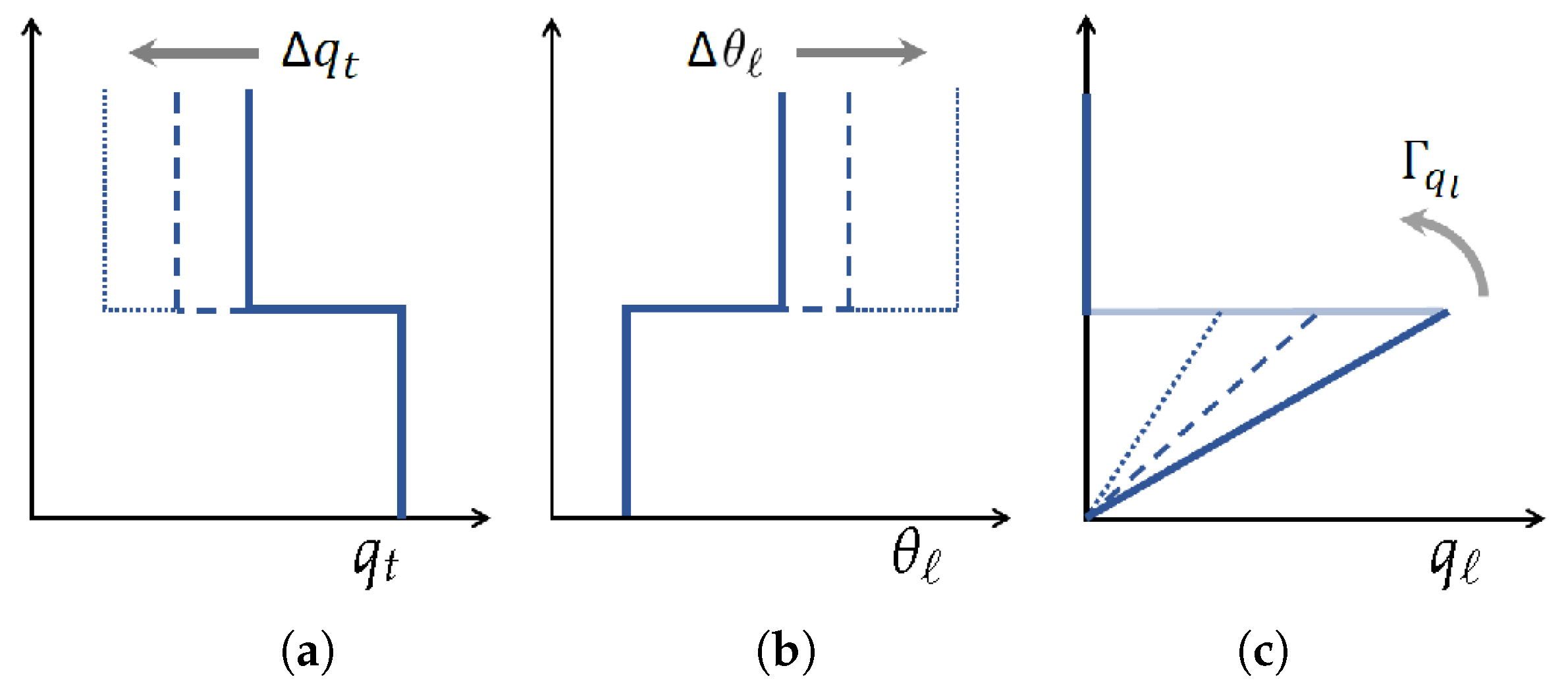

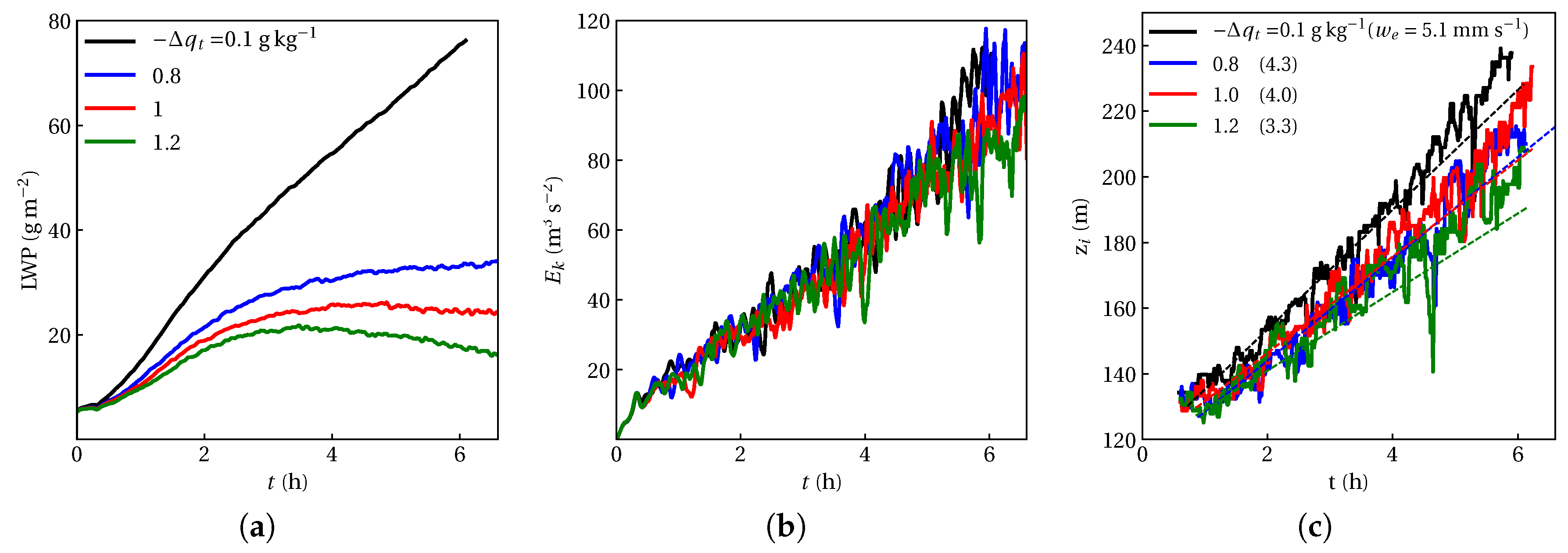
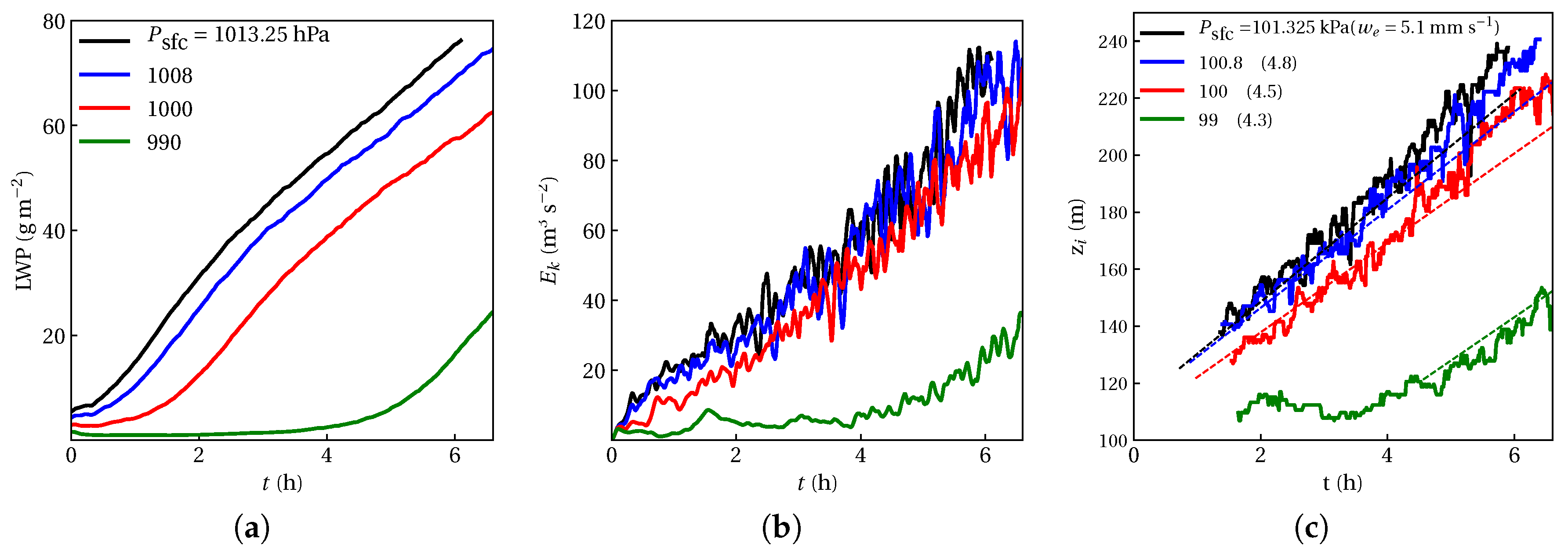
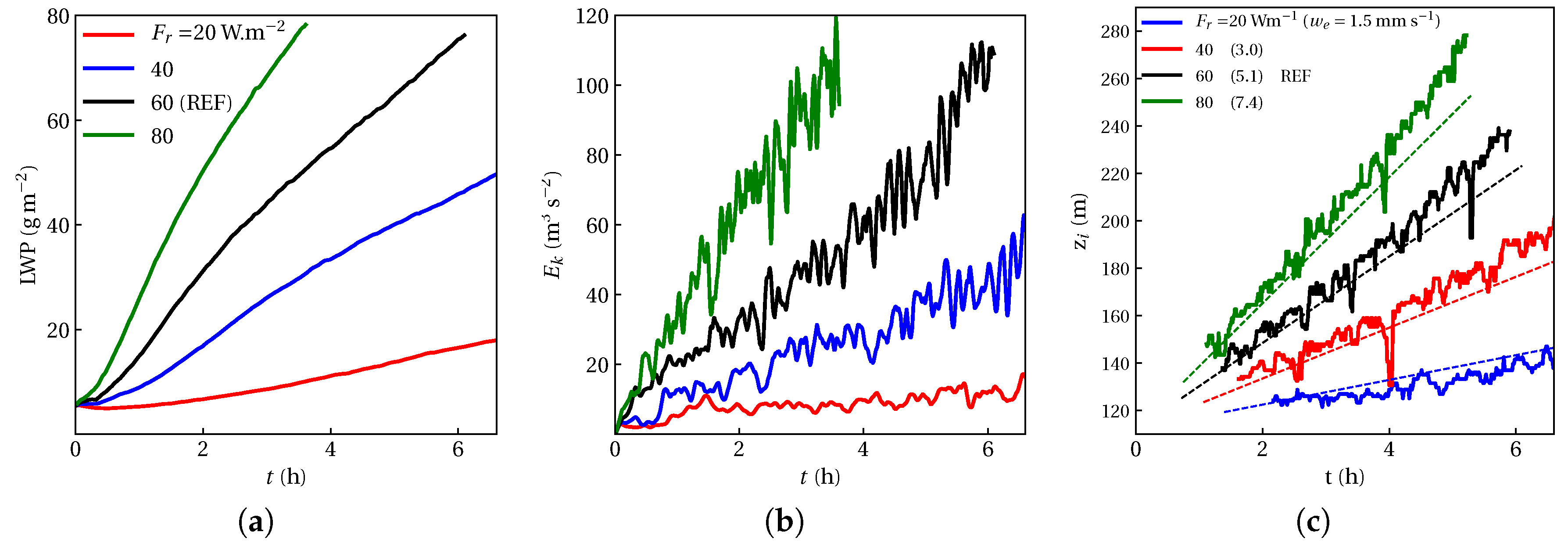
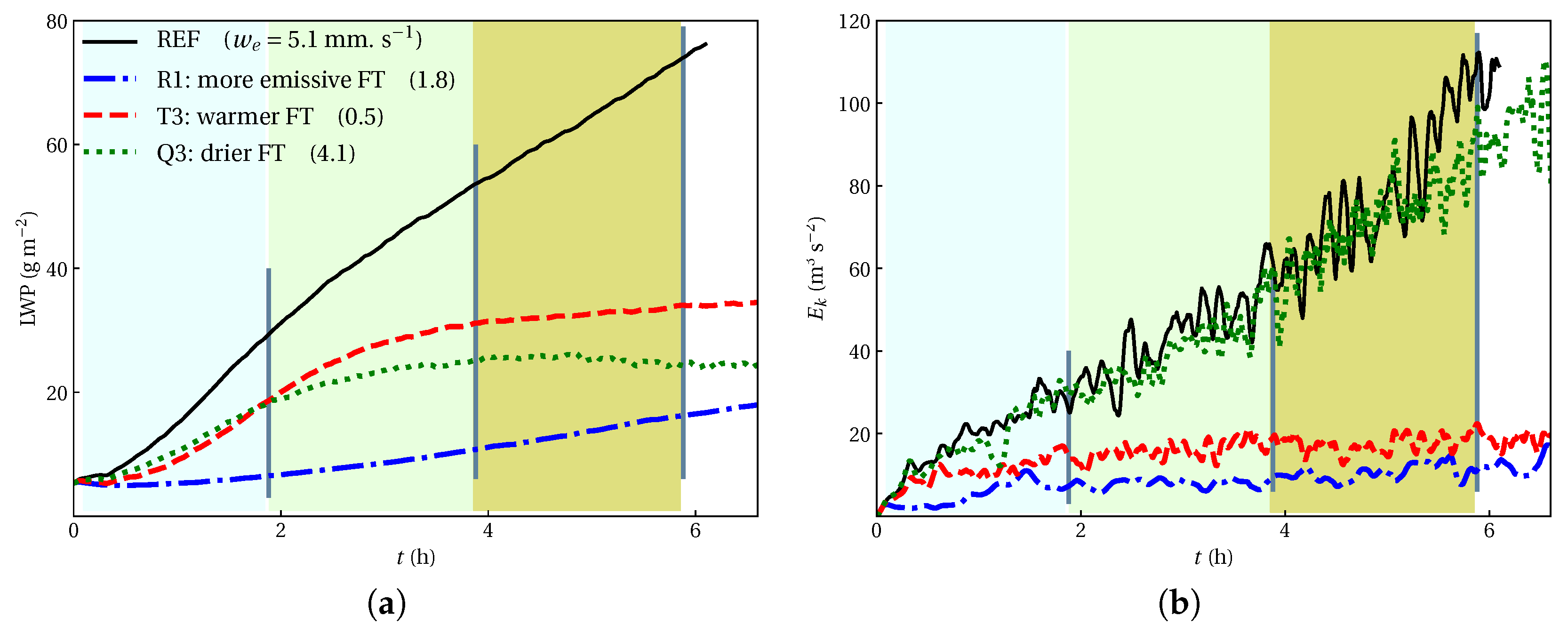
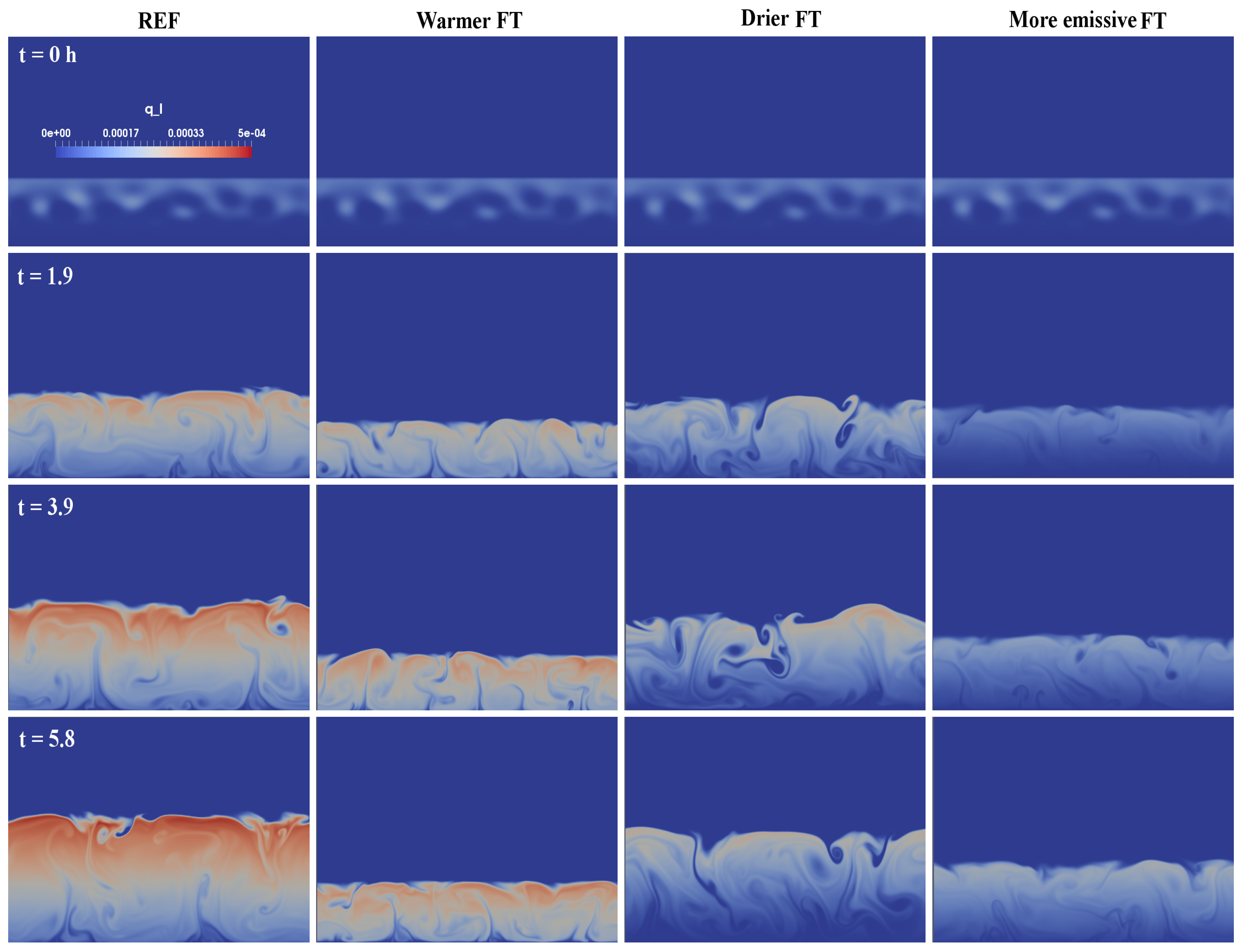
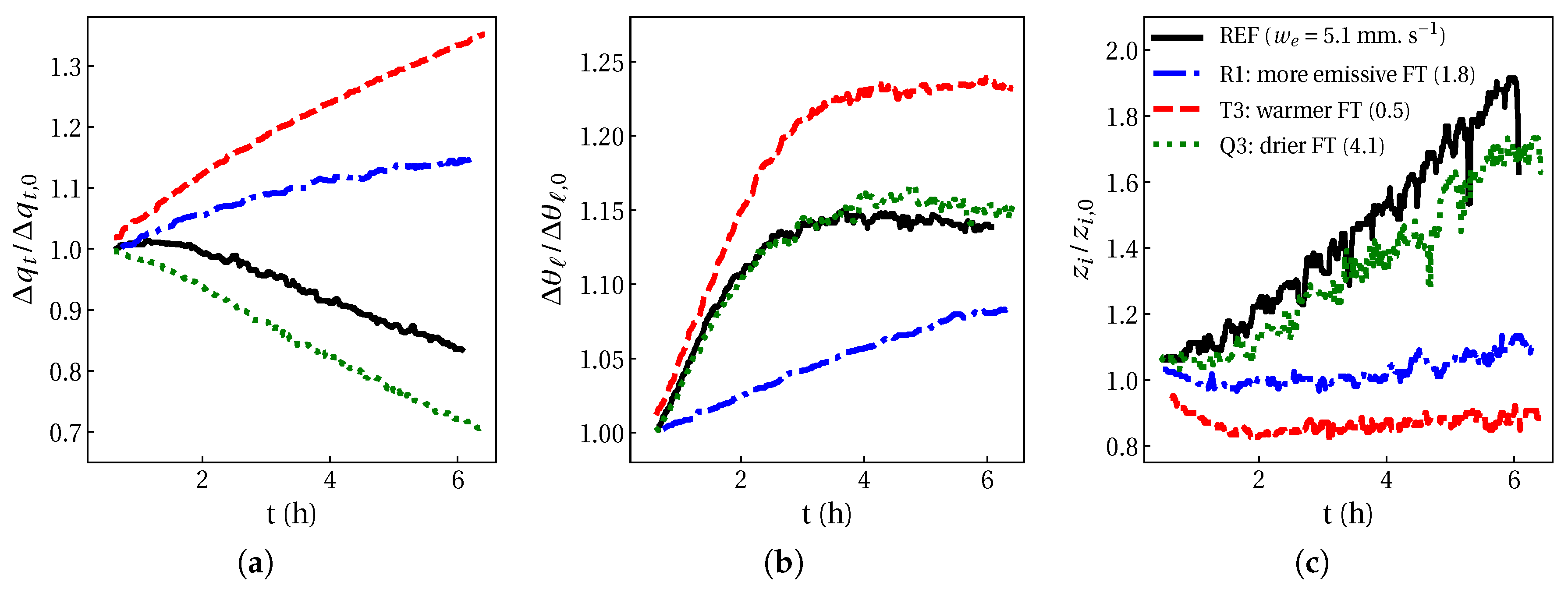

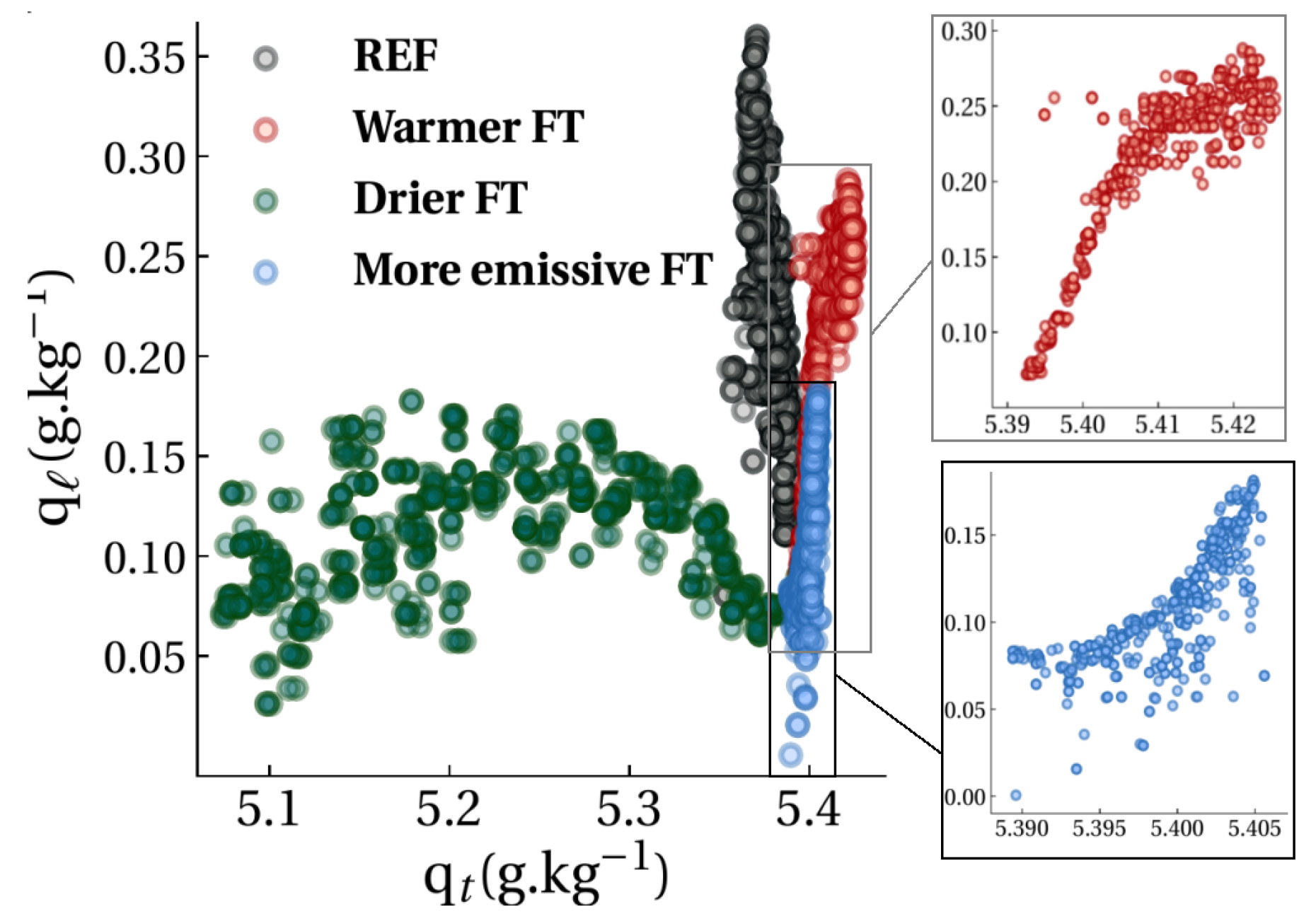
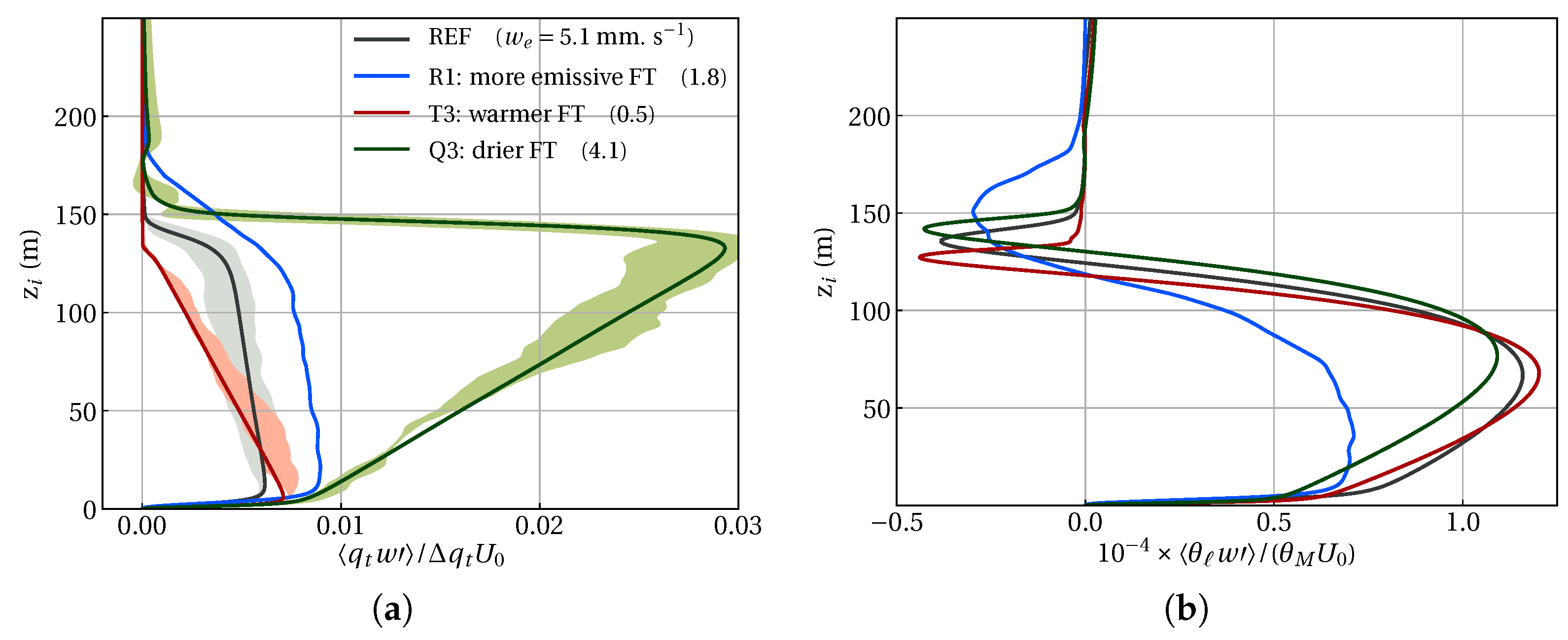
| Case | Input Parameter | Derived Parameters | ||||
|---|---|---|---|---|---|---|
| (gkg) | (K) | (hPa) | (Wm | (mms ) | (m) | |
| REF | 0.1 | 4.67 | 1013.25 | 60 | 5.1 | - |
| T1 | 0.1 | 8 | 1013.25 | 60 | 2.4 | - |
| T2 | 0.1 | 14 | 1013.25 | 60 | 1.3 | 125 |
| T3 | 0.1 | 21 | 1013.25 | 60 | 0.5 | 110 |
| Q1 | 0.8 | 4.67 | 1013.25 | 60 | 4.7 | 230 |
| Q2 | 1.0 | 4.67 | 1013.25 | 60 | 4.3 | 160 |
| Q3 | 1.2 | 4.67 | 1013.25 | 60 | 3.3 | 155 |
| L1 | 0.1 | 4.67 | 1008 | 60 | 4.8 | - |
| L2 | 0.1 | 4.67 | 1000 | 60 | 4.4 | - |
| L3 | 0.1 | 4.67 | 990 | 60 | 4.2 | - |
| R1 | 0.1 | 4.67 | 1013.25 | 20 | 1.5 | - |
| R2 | 0.1 | 4.67 | 1013.25 | 40 | 3.0 | - |
| R3 | 0.1 | 4.67 | 1013.25 | 80 | 7.4 | - |
© 2019 by the author. Licensee MDPI, Basel, Switzerland. This article is an open access article distributed under the terms and conditions of the Creative Commons Attribution (CC BY) license (http://creativecommons.org/licenses/by/4.0/).
Share and Cite
Karimi, M. Direct Numerical Simulation of Fog: The Sensitivity of a Dissipation Phase to Environmental Conditions. Atmosphere 2020, 11, 12. https://doi.org/10.3390/atmos11010012
Karimi M. Direct Numerical Simulation of Fog: The Sensitivity of a Dissipation Phase to Environmental Conditions. Atmosphere. 2020; 11(1):12. https://doi.org/10.3390/atmos11010012
Chicago/Turabian StyleKarimi, Mona. 2020. "Direct Numerical Simulation of Fog: The Sensitivity of a Dissipation Phase to Environmental Conditions" Atmosphere 11, no. 1: 12. https://doi.org/10.3390/atmos11010012
APA StyleKarimi, M. (2020). Direct Numerical Simulation of Fog: The Sensitivity of a Dissipation Phase to Environmental Conditions. Atmosphere, 11(1), 12. https://doi.org/10.3390/atmos11010012




